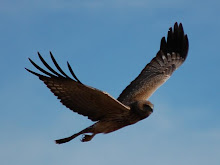The Birds in Backyards website conducts a survey tracking the arrival of koels and the locations they are seen or heard while they are here. I have kept a record of the dates I have first heard koels in Spring and they seem to be getting here slightly earlier each year:
2005 - 26 Sept
2006 - 18 Sept
2007 - 8 Sept
2008 - 15 Sept
2009 - 28 August
2006 - 18 Sept
2007 - 8 Sept
2008 - 15 Sept
2009 - 28 August
This is a juvenile Koel feeding from a date palm.

The male is entirely black with red eyes.



This is an adult female. Her back feathers are spotted and her belly feathers are barred.



The juvenile looks a lot like the female. It can often be distinguished by its clumsy flight, or the noise it makes crying out for food. The other distinguishing features are the lighter coloured head (the top of the adult females head is black) and brown eyes (where the adult's are red). (Simpson & Day, 1984).

This juvenile attracted my attention by the noise it made stumbling around the branches of a fig tree before it managed to find its way free:



I heard this juvenile calling for food when I was walking along the Cooks River near Tempe.


Being cuckoos, Koels lay their eggs in the nest of another species and have no involvement in raising their own chicks. In this case the Koel chick was being fed by a Red Wattlebird.

As part of the mating ritual, the black male brings berries to woo the more camouflaged female.


This juvenile is old enough to feed itself.


More information about Koels is available here:
Koels - Birds in Backyards
Koels - OzAnimals online
Koels - Wikipedia
Reference: Simpson, K. & Day, N. (1984). Field Guide to the Birds of Australia. Penguin, Ringwood, Victoria.



